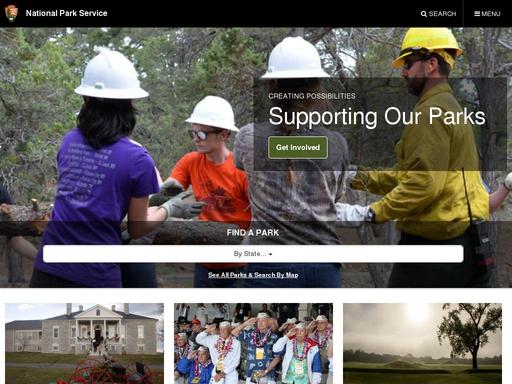Rate Grand Teton National Park
Learn and Explore
Since 1916, the National Park Service has been entrusted with the care of our national parks. With the help of volunteers and partners, we safeguard these special places and share their stories with more than 275 million visitors every year. But our work doesn’t stop there.
We are proud that tribes, local governments, nonprofit organizations, businesses, and individual citizens ask for our help in revitalizing their communities, preserving local history, celebrating local heritage, and creating close to home opportunities for kids and families to get outside, be active, and have fun.
Taking care of the national parks and helping Americans take care of their communities is a job we love, and we need—and welcome—your help and support.
Our Mission
The National Park Service preserves unimpaired the natural and cultural resources and values of the National Park System for the enjoyment, education, and inspiration of this and future generations. The Park Service cooperates with partners to extend the benefits of natural and cultural resource conservation and outdoor recreation throughout this country and the world.
Frequently Asked Questions
How do I obtain a park entrance pass?
Only 118 of your 417 park sites charge entrance fees. You can obtain park entrance passes by visiting a park site that charges an entrance fee. Entrance fee sites have passes available; we recommend calling a park prior to your visit. (See the park search to locate a specific park.) There are a number of entrance passes available, including park-specific passes as well as passes that offer entrance to more than 2,000 federal recreation sites in addition to the national parks (Annual, Military, Senior, 4th Grade, Access, and Volunteer passes). Learn more about the America the Beautiful – The National Parks and Federal Recreational Lands Pass.
About this location:
National Park
Operating Hours & Seasons
Grand Teton National Park
Visitors may enter the park at any time, but visitor services and motor vehicle access vary throughout the year.
Standard Hours
- Sunday:Open 24 hours
- Monday:Open 24 hours
- Tuesday:Open 24 hours
- Wednesday:Open 24 hours
- Thursday:Open 24 hours
- Friday:Open 24 hours
- Saturday:Open 24 hours
Fees & Passes
Entrance Fees:
- $30.00 – Grand Teton Entrance Fee – Private Vehicle
Park entrance fee for 7 days for a private, non-commercial vehicle. - $25.00 – Grand Teton Entrance Fee – Motorcycle
Park entrance for 7 days per private motorcycle. - $15.00 – Grand Teton Entrance Fee – Hiker/Biker
Park entrance fee for 7 days for a single hiker or bicyclist. - $50.00 – Grand Teton/Yellowstone Entrance Fee – Private Vehicle
Park entrance fees for both Grand Teton and Yellowstone national parks for 7 days for a private, non-commercial vehicle. - $40.00 – Grand Teton/Yellowstone Entrance Fee – Motorcycle
Park entrance fees for both Grand Teton and Yellowstone national parks for 7 days for a motorcycle. - $20.00 – Grand Teton/Yellowstone Entrance Fee – Hiker/Biker
Park entrance fees for both Grand Teton and Yellowstone national parks for 7 days for a single hiker or bicyclist.
Entrance Passes:
- $60.00 – Grand Teton Annual Pass
Park entrance for 12 months from month of purchase.
About
Mountains of the Imagination
Rising above a scene rich with extraordinary wildlife, pristine lakes, and alpine terrain, the Teton Range stands monument to the people who fought to protect it. These are mountains of the imagination. Mountains that led to the creation of Grand Teton National Park where you can explore over two hundred miles of trails, float the Snake River or enjoy the serenity of this remarkable place.
Directions
Grand Teton National Park is located in northwestern Wyoming north of the town of Jackson, Wyoming and south of Yellowstone National Park.
Visitor Centers
Craig Thomas Discovery & Visitor Center
The grand expanse of the Teton Range rises above the visitor center. Inside, interwoven themes of place, people, preservation, mountaineering and Native American Indians encourage visitors to contemplate the past, present and future of this place. Visit this facility for trip planning information, backcountry or boating permits. Shop at the Grand Teton Association bookstore, enjoy the variety of exhibits and artwork, attend a ranger program or watch a movie about the park. Jenny Lake Visitor Center
Harrison Crandall built this cabin in 1921 near the Cathedral Group Turnout as his studio. Today, the building displays two pieces of Crandall’s artwork and an original WPA Poster of Jenny Lake. Other exhibits focus on the geology and evolution of the landscape. Visit this facility for trip planning information and boat permits. The nearby Jenny Lake Ranger Station provides backcountry permits. Shop the Grand Teton Association bookstore, attend a ranger program or begin your backcountry adventure. Colter Bay Visitor Center
One of the surviving Mission 66 visitor centers, the Colter Bay Visitor Center provides great views of Jackson Lake. Inside, view 35 artifacts from the David T. Vernon Indian Arts Collection. The auditorium hosts ranger-led programs and shows a variety of park-related videos throughout the day. Visit this facility for trip planning information, backcountry or boating permits. Shop at the Grand Teton Association bookstore, attend a ranger-led program, or visit the nearby shops and restaurants. Laurance S. Rockefeller Preserve Center
The Laurance S. Rockefeller Preserve Center provides the opportunity to learn about Mr. Rockefeller’s vision for the area and his legacy of conservation stewardship. Exhibits engage visual, tactile and auditory senses through a poem by Terry Tempest Williams, audio recordings of Mr. Rockefeller, videos, photography, and a natural soundscape room. Visitors may relax in the resource room, attend a ranger program or strike out on a hike to Phelps Lake. The center does not have a sales area or offer permits. Jenny Lake Ranger Station
In the 1930s, the Jenny Lake Ranger Station and Museum opened as the park’s first visitor facility. Today, climbing rangers provide backcountry safety information, climbing route conditions and perform mountain rescues. A small raised-relief map features the core backcountry area and other exhibits address backcountry risks. A safety video provides visitors with essential information. The ranger station issues backcountry permits to climbers and all other backcountry users, but does not have a sales area. Flagg Ranch Information Station
The Flagg Ranch Information Station is located in the John D. Rockefeller, Jr. Memorial Parkway—the heart of the Greater Yellowstone Ecosystem. For visitors traveling south from Yellowstone National Park, Flagg Ranch is the first stop for trip planning information. This small wooden cabin is staffed daily during the peak summer season and includes a visitor information area, small sales area, exhibits depicting the Rockefeller legacy and restrooms.
Weather
Jackson Hole has long, cold winters; snow and frost are possible any month. mid-April, May & June – Mild days and cool nights alternate with rain and snow. July & August – Warm days and cool nights prevail, with afternoon thundershowers common. September, October & November – Sunny days and cold nights alternate with rain and occasional snowstorms. December to mid-April – Between storms the days are sunny and nights are frigid. Snow blankets the mountains and valley.







